2. 中国科学院生态环境研究中心, 中国科学院饮用水科学与技术重点实验室, 北京 100085;
3. 陕西省膜分离重点实验室, 西安 710055;
4. 青岛科技大学环境与安全工程学院, 青岛 266042
2. Key Laboratory of Drinking Water Science and Technology, Research Center for Eco-Environmental Sciences, Chinese Academy of Sciences, Beijing 100085, China;
3. Key Laboratory of Membrane Separation of Shaanxi Province, Xi'an 710055, China;
4. College of Environment and Safety Engineering, Qingdao University of Science and Technology, Qingdao 266042, China
塑料及其制品在工业、农业以及日常生活中被广泛使用, 自20世纪40年代开始大规模生产以来, 塑料的产量迅速增加.从20世纪50年代的1.5×106 t ·a-1大幅增加到2011年的2.8×108 t, 据估计目前全球每年产生的塑料产品超过3×108 t, 进入海洋的塑料垃圾至少8×106 t[1~3].残存在环境中的塑料具有化学性质稳定、密度低、粒径小等特点, 但在长期的太阳辐射、风力、海浪等物理或化学作用下会分解成塑料碎片或者颗粒, 当其粒径小于5 mm时被称为“微塑料”[4~6].
微塑料体积小、比表面积大和难降解, 容易吸附环境中的重金属、持久性有机污染物, 如农药、阻燃剂和多氯联苯等[7~11].微塑料作为载体, 可携带外来物种及潜在病原菌[12, 13], 破坏生态环境, 危害生物体健康.还可以由地表径流在海洋中蔓延, 改变海洋的生态环境, 进入海洋生物食物链, 对海洋生物造成危害, 并且随着食物链的传递作用, 微塑料最终进入人类的食物链, 造成更严重的危害[14~16].
前期的研究表明, 微塑料普遍存在于表层海水、河口以及沉积物中, 在极地冰川和河流湖泊沉积物中也有发现[17~22].近年来, 在淡水水源(河流、湖泊和水库等)也检测到了微塑料.据报道, 长江口微塑料平均丰度为(4.1×103±2.5×103) items ·m-3[23], 三峡大坝附近地表水微塑料丰度为1.6×103~1.23×104 items ·m-3[24].太湖的表层水体中也报道了微塑料的赋存, 丰度甚至达到3.4×106~25.8×106 items ·m-3[25].水体中已检测到的微塑料虽然种类繁多, 如聚乙烯(PE)、聚丙烯(PP)、聚氯乙烯(PVC)和聚苯乙烯等, 但PE的检出比例远高于其他种类[26].
截至目前, 混凝-膜滤工艺在饮用水处理工艺中已得到广泛应用[27~29].短流程膜工艺以其除污效能高、占地面积小等优点成为近年来重要的研究方向.随着微塑料在饮用水源地的逐渐检出, 了解微塑料对短流程膜工艺的运行效能影响显得至关重要.因此, 本文以水环境中丰度较高的聚乙烯为目标污染物, 考察了短流程膜工艺中, 微塑料对超滤膜污染的影响机制.
1 材料与方法 1.1 实验材料本实验所用试剂, 如FeCl3 ·6H2O、NaHCO3、HCl和NaOH均为分析纯, 购自国药集团化学试剂有限公司(北京).实验所用微塑料取自聚乙烯泡沫板, 经砂纸细磨后, 用分样筛将聚乙烯塑料分为不同粒径(2 < d1 < 5 mm、1 < d2 < 2 mm、0.5 < d3 < 1 mm和d4 < 0.5 mm).超滤杯(Amicon 8400)购自Millipore公司(美国).平板超滤膜(100×103)购自安德膜科技有限公司(北京), 材质为聚偏氟乙烯(PVDF).
1.2 实验装置与方法本实验装置如图 1所示.向超滤杯内注入300 mL去离子水, 随后加入一定量的NaOH或HCl (0.01 mol ·L-1), 为使体系中pH混凝后稳定在6.0、7.0和8.0, 加入3 mL NaHCO3(0.1 mol ·L-1)作为缓冲溶液.之后, 加入0.1 g微塑料.快转(350 r ·min-1)1 min, 慢转(100 r ·min-1)14 min, 进行膜过滤.采用10 mg ·L-1氯化钠作为背景离子强度.本实验过程中用膜比通量J/J0代表膜污染状况, 其中J0为初始膜通量.膜比通量越大, 表示膜污染程度越轻.所有实验至少两次平行.
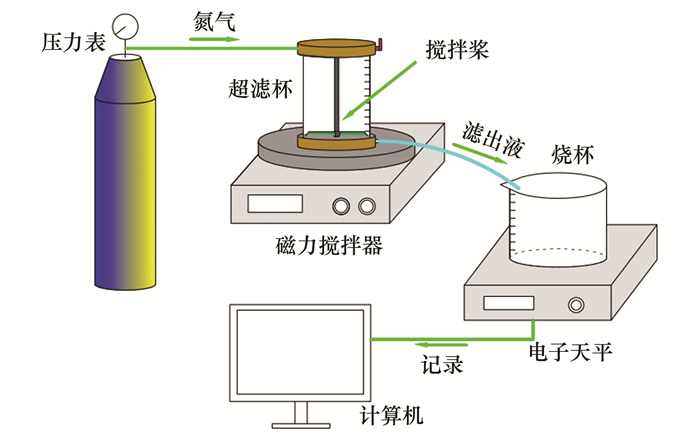
|
图 1 实验装置示意 Fig. 1 Schematic diagram of the experimental set up |
pH通过Orion pH Benchtop测定; 膜通量通过数字记录仪(HCB1002, Denver, USA)自动存储; 膜表面形貌通过扫描电子显微镜(JEOL Ltd, Tokyo, Japan)和相机((Nikon, Coolpix P7100, Japan)测定, 相机拍摄时, 由于所用微塑料和超滤膜均为白色, 拍摄前用亚甲基蓝将微塑料染色2 h(除加0.9 mmol ·L-1氯化铁时); 絮体粒径通过Mastersizer 2000激光粒度仪测定(Malvern, UK); Zeta电位通过Delsa Nano C(Beckman Coulter, USA)测定.
2 结果与讨论 2.1 微塑料引起的膜污染首先考察了pH 7.0时0.1 g不同粒径微塑料的膜污染行为.由图 2(a)所示, 微塑料粒径越小, 膜比通量越低, 膜污染程度越严重.微塑料粒径分别为2 < d1 < 5 mm、1 < d2 < 2 mm、0.5 < d3 < 1 mm和d4 < 0.5 mm时, 膜比通量依次降低为0.87、0.85、0.84和0.83(选取前600 s膜比通量变化, 下同).由于所用超滤膜的平均孔径为(47.9±6.4) nm, 微塑料本身并不会吸附或者堵塞超滤膜孔, 此时引起超滤膜污染的主要方式是微塑料形成的滤饼层.微塑料粒径越小, 在超滤膜表面形成的滤饼层相对致密, 膜污染越严重, 但膜污染加剧的趋势不明显.
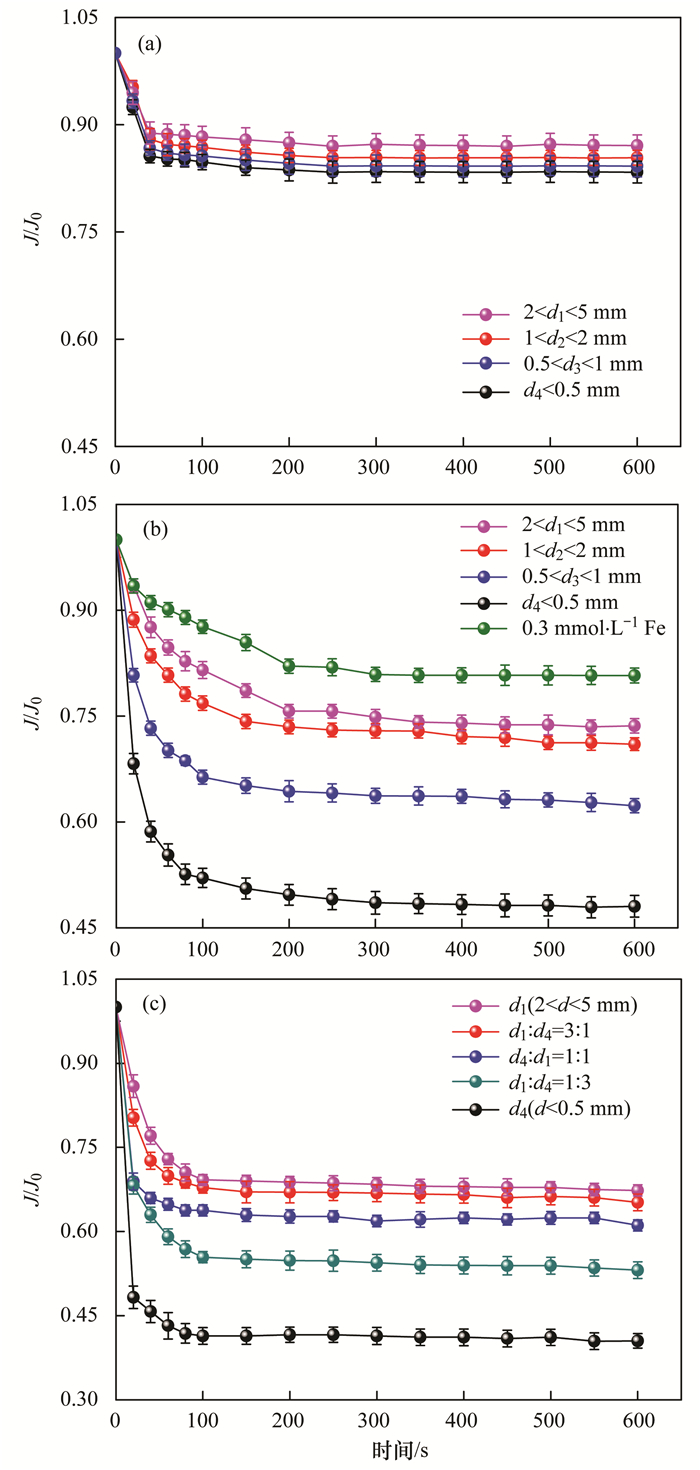
|
(a)单独微塑料; (b)微塑料混凝后; (c)不同粒径比例微塑料混合物混凝后 图 2 pH 7.0时不同粒径微塑料混凝前后引起的膜污染 Fig. 2 Membrane fouling caused by microplastics with different particle sizes before and after coagulating at pH 7.0 |
进一步考察了铁盐与不同粒径微塑料混凝后导致的膜污染.由图 2(b)可知, 单独铁盐(0.3 mmol ·L-1)时, 松散的水解絮体引起的膜污染程度较轻, 膜比通量为0.81.而铁盐与微塑料混凝后, 滤饼层厚度增加, 膜污染加剧, 尤其小粒径微塑料.此时膜比通量分别为0.74(d1)、0.71(d2)、0.62(d3)和0.48(d4), 膜污染加剧程度远高于无混凝剂时[图 2(a)].
为进一步验证小粒径微塑料能严重加剧膜污染, 考察了不同粒径微塑料(2 < d1 < 5 mm、d4 < 0.5 mm)以不同比例混合后膜污染程度.如图 2(c)所示, 粒径2~5 mm的微塑料与氯化铁絮体混凝后导致的膜比通量为0.68.然而, 在保持投加总量一致的情况下, 随着小粒径微塑料比例的增大, 膜污染程度严重加剧, 此时膜比通量逐渐降低为0.65(d1 :d4=3 :1)、0.61(d1 :d4=1 :1)、0.53(d1 :d4=1 :3)和0.43(d4 < 0.5 mm).
2.2 铁盐浓度的影响一方面, 膜污染随微塑料粒径减小而加剧.另一方面, 混凝剂投量随水质不同而改变[30~32].进一步研究了小粒径微塑料(d4 < 0.5 mm)与不同浓度铁盐混凝后导致的膜污染.首先考察了混凝剂本身对膜污染的影响.结果表明, 膜比通量随铁盐投量的增加而逐渐降低.当混凝剂浓度分别为0.1、0.3、0.6和0.9 mmol ·L-1时, 膜比通量为0.82、0.81、0.77和0.76[图 3(a)].仅0.1 mmol ·L-1铁盐时, 膜污染程度最轻[图 4(a)].尽管膜污染程度随混凝剂投量增加而加剧, 但混凝剂水解絮体松散, 膜污染加剧程度也不明显, 运行结束后膜比通量仅变化0.06.
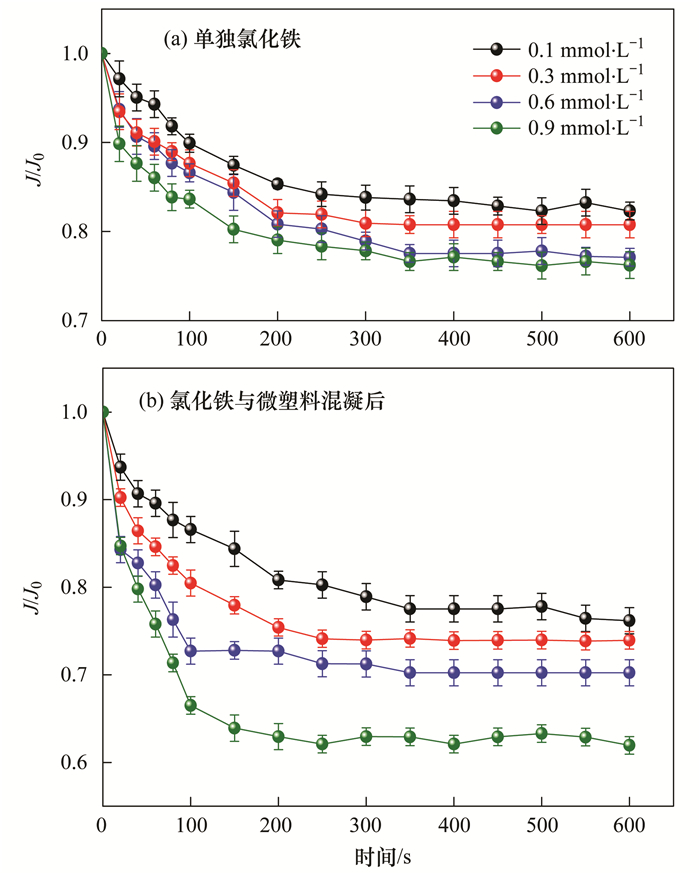
|
图 3 pH 7.0时微塑料混凝前后膜比通量 Fig. 3 Membrane specific flux caused by microplastics before and after coagulation at pH 7.0 |

|
(a) 0.1 mmol ·L-1氯化铁; (b) 0.1 mmol ·L-1氯化铁与0.1 g微塑料(d4 < 0.5 mm)混凝; (c) 0.9 mmol ·L-1氯化铁与0.1 g微塑料(d4 < 0.5 mm)混凝 图 4 pH 7.0时微塑料混凝前后超滤膜表面形貌 Fig. 4 Surface morphology of membrane caused by microplastics before and after coagulation at pH 7.0 |
而与小粒径微塑料(d4 < 0.5 mm)混凝后, 膜污染程度明显加剧, 此时, 膜比通量分别降低为0.76、0.74、0.70和0.62[图 3(b)].从图 4中可以看出, 混凝后絮体与微塑料相对均匀地分布在超滤膜表面[图 4(b)和4(c)], 滤饼层更致密, 因而膜污染程度更严重.随着铁盐浓度的增加, 滤饼层厚且致密, 膜污染程度进一步加剧, 运行结束后膜比通量变化0.14.
2.3 pH的影响絮体的性质受pH影响较大[33], 进一步研究了不同pH条件下微塑料对膜污染程度的影响.从图 5可以看出, 膜污染程度随pH升高而降低. pH为6.0、7.0和8.0时, 单独0.3 mmol ·L-1氯化铁水解絮体造成的膜比通量分别为0.70、0.76和0.81.与小粒径微塑料(d4 < 0.5 mm)混凝后, 膜污染程度加剧, 尤其酸性条件下, 相应膜比通量分别为0.55、0.69和0.79.
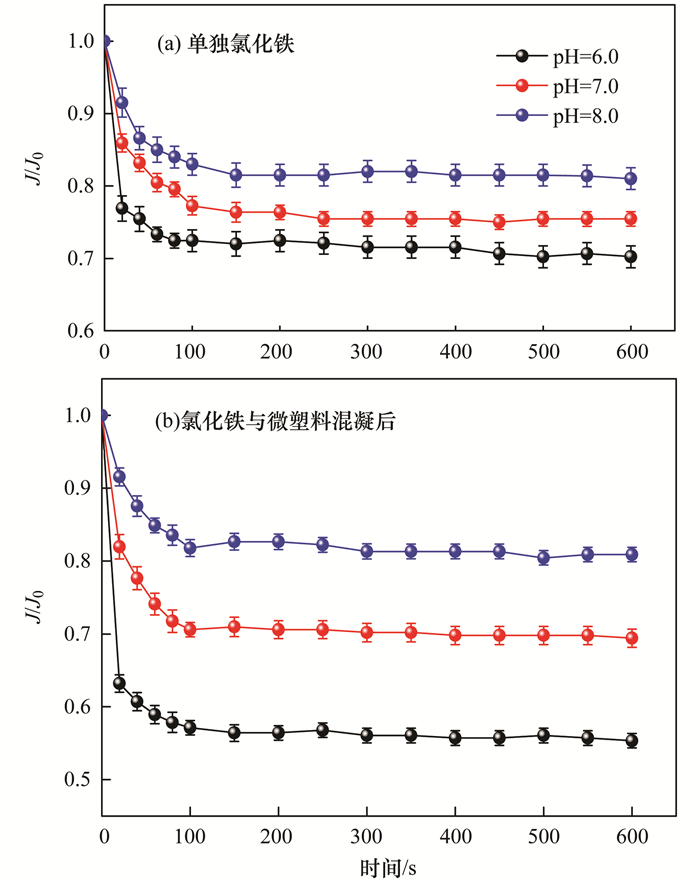
|
图 5 不同pH条件下0.3 mmol ·L-1氯化铁与微塑料混凝后引起的膜污染 Fig. 5 Membrane fouling caused by microplastics after coagulating with 0.3 mmol ·L-1 FeCl3 ·6H2O under different pH conditions |
进一步研究表明, 膜污染程度随pH降低而加剧归于以下原因:①pH 6.0、7.0和8.0时, 0.3 mmol ·L-1氯化铁水解絮体的表面电荷大部分呈正电, 分别为(10.16±2.81)、(3.96±0.84)和(-23.68±0.69) mV, 而此时微塑料的表面电位呈负电, 分别为(-6.98±1.11)、(-13.32±6.89)和(-15.05±4.66) mV[图 6(a)], 低pH时微塑料更易被絮体吸附; ②氯化铁水解絮体平均粒径(d50)随pH增加而增大[图 6(b)], pH 6.0、7.0和8.0的平均粒径分别为413 μm、622 μm和694 μm.低pH时絮体粒径小, 在超滤膜表面形成的滤饼层更致密[图 6(c)和6(d)], 加剧膜污染.
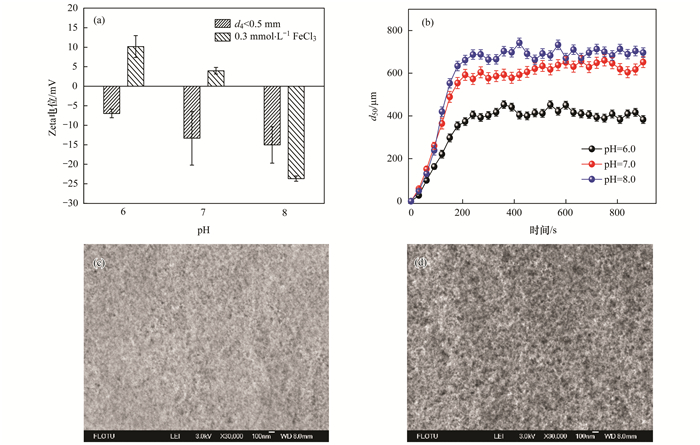
|
(a)氯化铁水解絮体和微塑料Zeta电位; (b)氯化铁水解絮体粒径变化; (c)和(d) pH 6.0和pH 8.0絮体在超滤膜表面形貌 图 6 不同pH时絮体性质及膜表面形貌 Fig. 6 Properties of flocs and surface morphology of membranes at different pH value |
综上所述, 微塑料单独存在时, 由于其粒径远大于膜孔, 膜污染程度较轻.在短流程膜工艺中, 微塑料与铁盐混凝后直接进入膜池, 且相对均匀地分散在膜表面.随着铁盐投量增加, 滤饼层厚度相应增加, 此时小粒径微塑料可能进入絮体内部网络空间, 滤饼层更致密, 进一步加剧膜污染.与碱性环境相比, 酸性环境时, 铁盐絮体表面带正电荷且粒径较小, 更容易吸附/捕获水环境中呈负电性的微塑料, 在膜表面形成的滤饼层也更致密, 膜污染程度严重.微塑料混凝前后引起膜污染的机制示意图见图 7.
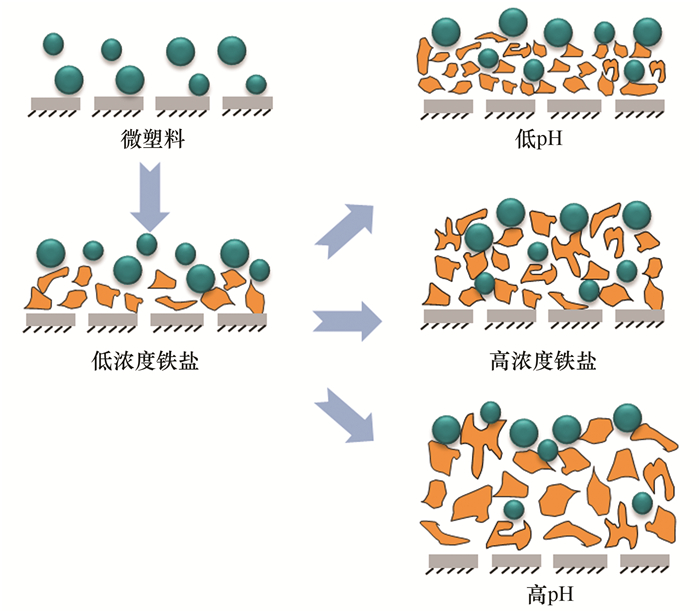
|
图 7 微塑料混凝前后超滤膜污染机制示意 Fig. 7 Schematic diagram of UF membrane fouling mechanisms induced by microplastics before and after coagulation |
以上研究表明, 小粒径微塑料能急剧加剧膜污染.理论上讲, 低压滤膜(微滤和超滤)由于孔径小, 可将混凝前后微塑料全部截留, 所形成的滤饼层相对松散, 且绝大部分为可逆污染.然而, 受机械、光解和微生物等作用, 微塑料会进一步分解成纳米尺度塑料.随着微纳塑料在环境中的检出, 其对水质尤其膜污染的影响更严重.在实际水环境中, 微纳塑料本身是污染物, 更重要的是, 微纳塑料可作为优良载体, 不仅能有效吸附重金属、持久性有机污染物等有毒物质, 也容易滋养、携带病原菌等微生物, 成为严重的污染源.微纳塑料作为一种新型污染物, 当前的研究多以检测方法、吸附效能和毒理学效应等为主, 后续应多关注微纳塑料作为载体滋养微生物对膜污染的影响, 尤其纳塑料.
3 结论(1) 微塑料对超滤膜污染程度影响较低, 但小粒径微塑料, 尤其混凝后形成致密的滤饼层能显著加剧膜污染.
(2) 超滤膜污染程度随混凝剂投量增大而加剧.混凝过程中, 大粒径微塑料往往被拦截于絮体表面, 而小粒径微塑料容易进入絮体形成的内部网络, 形成致密滤饼层, 加剧膜污染.
(3) 水体中微塑料多呈负电, 酸性条件下氯化铁水解絮体粒径较小且带正电荷, 易吸附微塑料形成致密滤饼层, 引起严重的膜污染.
| [1] | Plastics Europe. Plastics-The Facts 2012: an analysis of European plastics production, demand and waste data for 2011[R]. Brussels: Association of Plastic Manufacturers, 2012, 38. |
| [2] |
许旺, 梁鸿, 马嵩, 等. 我国海岸带系统微塑料污染危害及治理对策[J]. 环境与可持续发展, 2018, 43(2): 21-26. Xu W, Liang H, Ma S, et al. Microplastics pollution and manage countermeasures in the coastal environment of China[J]. Environment and Sustainable Development, 2018, 43(2): 21-26. DOI:10.3969/j.issn.1673-288X.2018.02.005 |
| [3] | 柴勇, 王寒冰, 张钰, 等. 致命的海洋垃圾[J]. 人与自然, 2017(11): 10-25. |
| [4] |
王昆, 林坤德, 袁东星. 环境样品中微塑料的分析方法研究进展[J]. 环境化学, 2017, 36(1): 27-36. Wang K, Lin K D, Yuan D X. Research progress on the analysis of microplastics in the environment[J]. Environmental Chemistry, 2017, 36(1): 27-36. |
| [5] | Wagner M, Scherer C, Alvarez-Muñoz D, et al. Microplastics in freshwater ecosystems:what we know and what we need to know[J]. Environmental Sciences Europe, 2014, 26(1): 12. DOI:10.1186/s12302-014-0012-7 |
| [6] |
徐擎擎, 张哿, 邹亚丹, 等. 微塑料与有机污染物的相互作用研究进展[J]. 生态毒理学报, 2018, 13(1): 40-49. Xu Q Q, Zhang G, Zou Y D, et al. Interactions between microplastics and organic pollutants:current status and knowledge gaps[J]. Asian Journal of Ecotoxicology, 2018, 13(1): 40-49. |
| [7] | Eriksen M, Liboiron M, Kiessling T, et al. Microplastic sampling with the AVANI trawl compared to two neuston trawls in the bay of Bengal and South Pacific[J]. Environmental Pollution, 2018, 232: 430-439. DOI:10.1016/j.envpol.2017.09.058 |
| [8] | Li H X, Getzinger G J, Ferguson P L, et al. Effects of toxic leachate from commercial plastics on larval survival and settlement of the barnacle Amphibalanus amphitrite[J]. Environmental Science & Technology, 2016, 50(2): 924-931. |
| [9] | Hermabessiere L, Dehaut A, Paul-Pont I, et al. Occurrence and effects of plastic additives on marine environments and organisms:a review[J]. Chemosphere, 2017, 182: 781-793. DOI:10.1016/j.chemosphere.2017.05.096 |
| [10] | Kolandhasamy P, Su L, Li J N, et al. Adherence of microplastics to soft tissue of mussels:a novel way to uptake microplastics beyond ingestion[J]. Science of the Total Environment, 2018, 610-611: 635-640. DOI:10.1016/j.scitotenv.2017.08.053 |
| [11] | Ma B W, Xue W J, Hu C Z, et al. Characteristics of microplastic removal via coagulation and ultrafiltration during drinking water treatment[J]. Chemical Engineering Journal, 2019, 359: 159-167. DOI:10.1016/j.cej.2018.11.155 |
| [12] | Brennecke D, Duarte B, Paiva F, et al. Microplastics as vector for heavy metal contamination from the marine environment[J]. Estuarine, Coastal and Shelf Science, 2016, 178: 189-195. DOI:10.1016/j.ecss.2015.12.003 |
| [13] | Foulon V, Le Roux F, Lambert C, et al. Colonization of polystyrene microparticles by Vibrio crassostreae:light and electron microscopic investigation[J]. Environmental Science & Technology, 2016, 50(20): 10988-10996. |
| [14] | Farrell P, Nelson K. Trophic level transfer of microplastic:Mytilus edulis (L.) to Carcinus maenas (L.)[J]. Environmental Pollution, 2013, 177: 1-3. DOI:10.1016/j.envpol.2013.01.046 |
| [15] | Pellini G, Gomiero A, Fortibuoni T, et al. Characterization of microplastic litter in the gastrointestinal tract of Solea solea from the Adriatic Sea[J]. Environmental Pollution, 2018, 234: 943-952. DOI:10.1016/j.envpol.2017.12.038 |
| [16] |
邹亚丹, 徐擎擎, 张哿, 等. 6种消解方法对荧光测定生物体内聚苯乙烯微塑料的影响[J]. 环境科学, 2019, 40(1): 496-503. Zou Y D, Xu Q Q, Zhang G, et al. Influence of six digestion methods on the determination of polystyrene microplastics in organisms using the fluorescence intensity[J]. Environmental Science, 2019, 40(1): 496-503. |
| [17] | Fischer V, Elsner N O, Brenke N, et al. Plastic pollution of the Kuril-Kamchatka Trench area (NW pacific)[J]. Deep Sea Research Part Ⅱ:Topical Studies in Oceanography, 2015, 111: 399-405. DOI:10.1016/j.dsr2.2014.08.012 |
| [18] | Bergmann M, Wirzberger V, Krumpen T, et al. High quantities of microplastic in Arctic deep-sea sediments from the HAUSGARTEN observatory[J]. Environmental Science & Technology, 2017, 51(19): 11000-11010. |
| [19] | Peng G Y, Zhu B S, Yang D Q, et al. Microplastics in sediments of the Changjiang estuary, China[J]. Environmental Pollution, 2017, 225: 283-290. DOI:10.1016/j.envpol.2016.12.064 |
| [20] | Zhang W W, Zhang S F, Wang J Y, et al. Microplastic pollution in the surface waters of the Bohai Sea, China[J]. Environmental Pollution, 2017, 231: 541-548. DOI:10.1016/j.envpol.2017.08.058 |
| [21] |
简敏菲, 周隆胤, 余厚平, 等. 鄱阳湖-饶河入湖段湿地底泥中微塑料的分离及其表面形貌特征[J]. 环境科学学报, 2018, 38(2): 579-586. Jian M F, Zhou L Y, Yu H P, et al. Separation and microscopic study of microplastics from the sediments of the wetland in the estuary of Raohe River of Poyang Lake[J]. Acta Scientiae Circumstantiae, 2018, 38(2): 579-586. |
| [22] |
朱晓桐, 衣俊, 强丽媛, 等. 长江口潮滩表层沉积物中微塑料的分布及沉降特点[J]. 环境科学, 2018, 39(5): 2067-2074. Zhu X T, Yi J, Qiang L Y, et al. Distribution and settlement of microplastics in the surface sediment of Yangtze Estuary[J]. Environmental Science, 2018, 39(5): 2067-2074. |
| [23] | Zhao S Y, Zhu L X, Wang T, et al. Suspended microplastics in the surface water of the Yangtze Estuary System, China:first observations on occurrence, distribution[J]. Marine Pollution Bulletin, 2014, 86(1-2): 562-568. DOI:10.1016/j.marpolbul.2014.06.032 |
| [24] | Di M X, Wang J. Microplastics in surface waters and sediments of the Three Gorges Reservoir, China[J]. Science of the Total Environment, 2018, 616-617: 1620-1627. DOI:10.1016/j.scitotenv.2017.10.150 |
| [25] | Su L, Xue Y G, Li L G, et al. Microplastics in Taihu Lake, China[J]. Environmental Pollution, 2016, 216: 711-719. DOI:10.1016/j.envpol.2016.06.036 |
| [26] | Andrady A L. Microplastics in the marine environment[J]. Marine Pollution Bulletin, 2011, 62(8): 1596-1605. DOI:10.1016/j.marpolbul.2011.05.030 |
| [27] |
王雨菲.基于"后絮凝"控制的混凝-膜过滤饮用水处理技术研究[D].天津: 天津大学, 2017. Wang Y F. Study of coagulation-Membrane filtration technology for drinking water treatment based on re-flocculation control[D]. Tianjin: Tianjin University, 2017. |
| [28] |
李满屯, 贾瑞宝, 于衍真, 等. 超滤膜工艺技术在饮用水处理的应用研究进展[J]. 净水技术, 2012, 31(6): 18-21. Li M T, Jia R B, Yu Y Z, et al. Advances in application research of technological processes of ultrafiltration membrane in drinking water treatment[J]. Water Purification Technology, 2012, 31(6): 18-21. DOI:10.3969/j.issn.1009-0177.2012.06.005 |
| [29] |
付宛宜, 张锡辉, 叶挺进, 等. 超滤膜及其组合工艺在饮用水处理中的应用[J]. 中国给水排水, 2013, 29(22): 1-6. Fu W Y, Zhang X H, Ye T J, et al. Application of ultrafiltration and its combined process in drinking water treatment[J]. China Water & Wastewater, 2013, 29(22): 1-6. |
| [30] | Sillanpää M, Ncibi M C, Matilainen A, et al. Removal of natural organic matter in drinking water treatment by coagulation:a comprehensive review[J]. Chemosphere, 2017, 190: 54-71. |
| [31] | Duan J M, Gregory J. Coagulation by hydrolysing metal salts[J]. Advances in Colloid and Interface Science, 2003, 100-102: 475-502. DOI:10.1016/S0001-8686(02)00067-2 |
| [32] |
潘世英, 万吉昌, 高宝玉, 等. 混凝实验条件下混凝剂最佳投加量的选择方法研究[J]. 工业水处理, 2011, 31(10): 25-27. Pan S Y, Wan J C, Gao B Y, et al. Studies on the determination of optimum dosage of coagulant under different coagulation experimental conditions[J]. Industrial Water Treatment, 2011, 31(10): 25-27. |
| [33] |
马百文.絮体与超滤膜协同作用下的净水效能与机制[D].北京: 中国科学院大学, 2015. Ma B W. Ultrafiltration membrane purification efficiency and mechanism with the synergistic effect of flocs[D]. Beijing: University of Chinese Academy of Sciences, 2015. |
 2019, Vol. 40
2019, Vol. 40


